Change Management: Resistance, Leadership, and Organizational Change
VerifiedAdded on 2021/04/21
|21
|4741
|34
Report
AI Summary
This report provides a comprehensive analysis of change management processes, focusing on the resistances encountered by organizations during structural changes. It delves into the concept of 'wicked problems' and their origins in conflicting ideas and workforce capabilities. The report explores the influence of leadership behaviors, economic factors, and employee job security on the change process, highlighting how these elements contribute to resistance. It further examines how resistance can both undermine and enable organizational change, with discussions on planning, misunderstandings, and the impact on an organization's image. The report also addresses leadership strategies, complexities in leadership, uncertainty in decision-making, and the paradox of leadership during change management. Finally, the report discusses the role of trust relations and top-down change management approaches. The report uses examples like Nokia, Coca-Cola, IBM, and Walmart to illustrate the concepts.
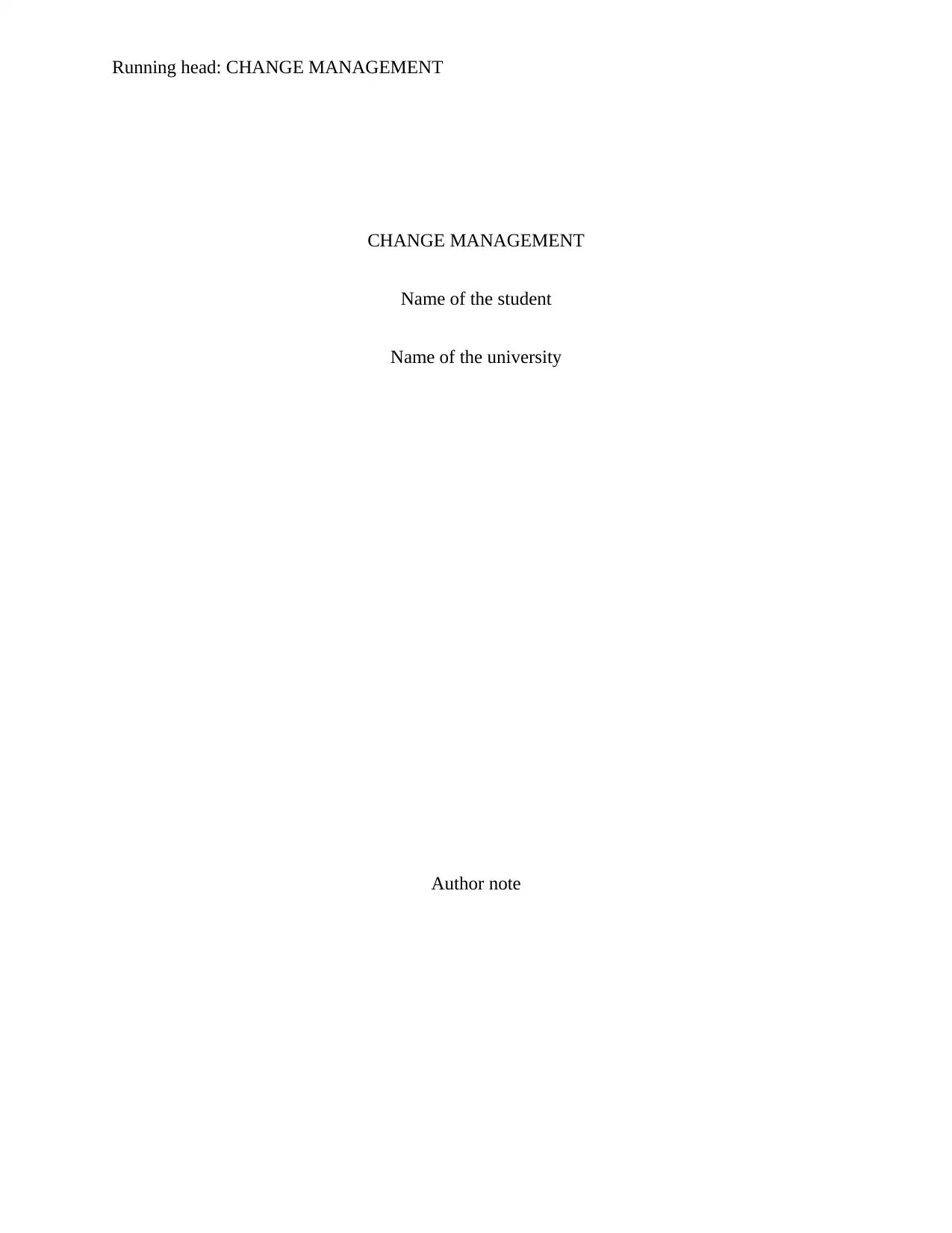
Running head: CHANGE MANAGEMENT
CHANGE MANAGEMENT
Name of the student
Name of the university
Author note
CHANGE MANAGEMENT
Name of the student
Name of the university
Author note
Paraphrase This Document
Need a fresh take? Get an instant paraphrase of this document with our AI Paraphraser
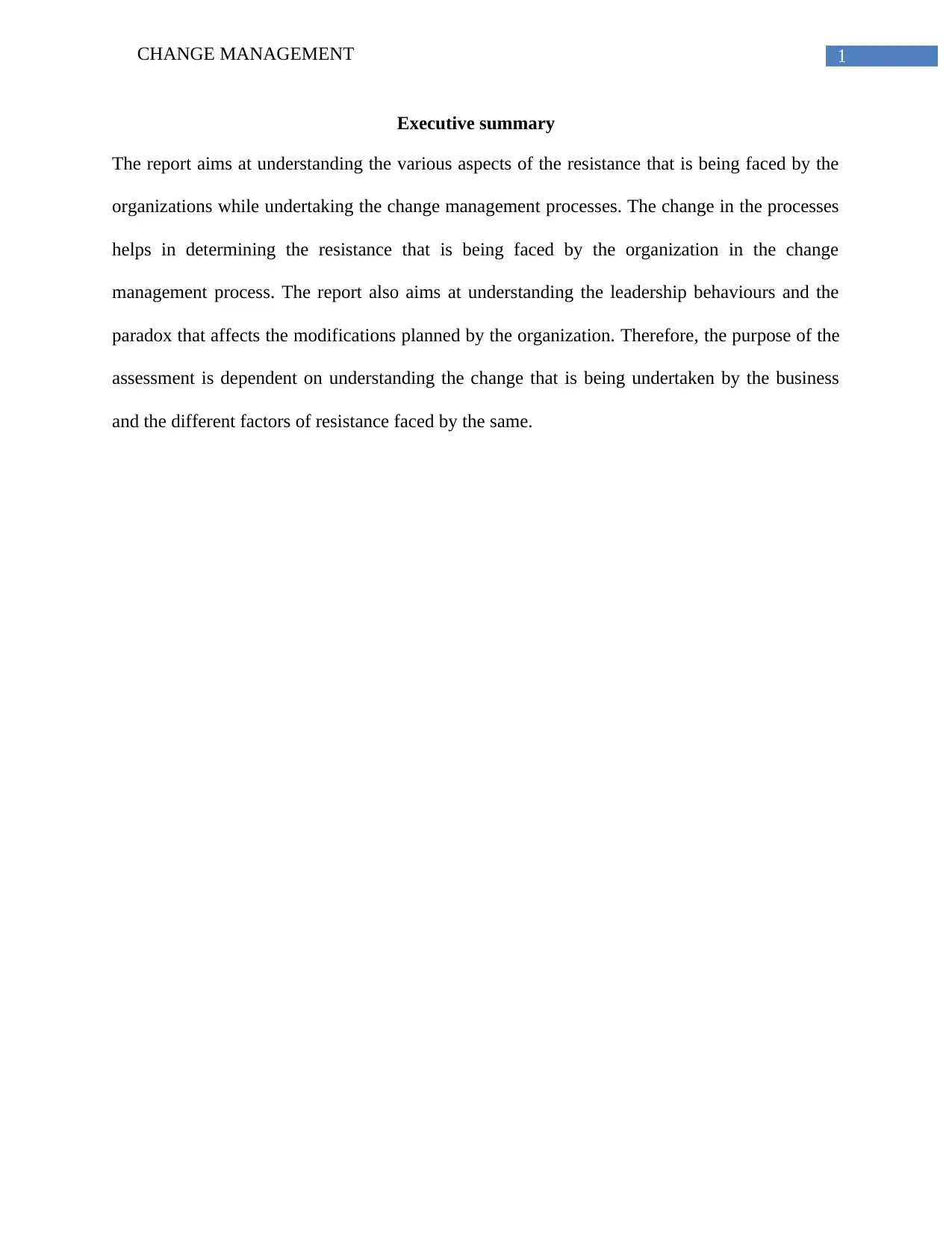
1CHANGE MANAGEMENT
Executive summary
The report aims at understanding the various aspects of the resistance that is being faced by the
organizations while undertaking the change management processes. The change in the processes
helps in determining the resistance that is being faced by the organization in the change
management process. The report also aims at understanding the leadership behaviours and the
paradox that affects the modifications planned by the organization. Therefore, the purpose of the
assessment is dependent on understanding the change that is being undertaken by the business
and the different factors of resistance faced by the same.
Executive summary
The report aims at understanding the various aspects of the resistance that is being faced by the
organizations while undertaking the change management processes. The change in the processes
helps in determining the resistance that is being faced by the organization in the change
management process. The report also aims at understanding the leadership behaviours and the
paradox that affects the modifications planned by the organization. Therefore, the purpose of the
assessment is dependent on understanding the change that is being undertaken by the business
and the different factors of resistance faced by the same.
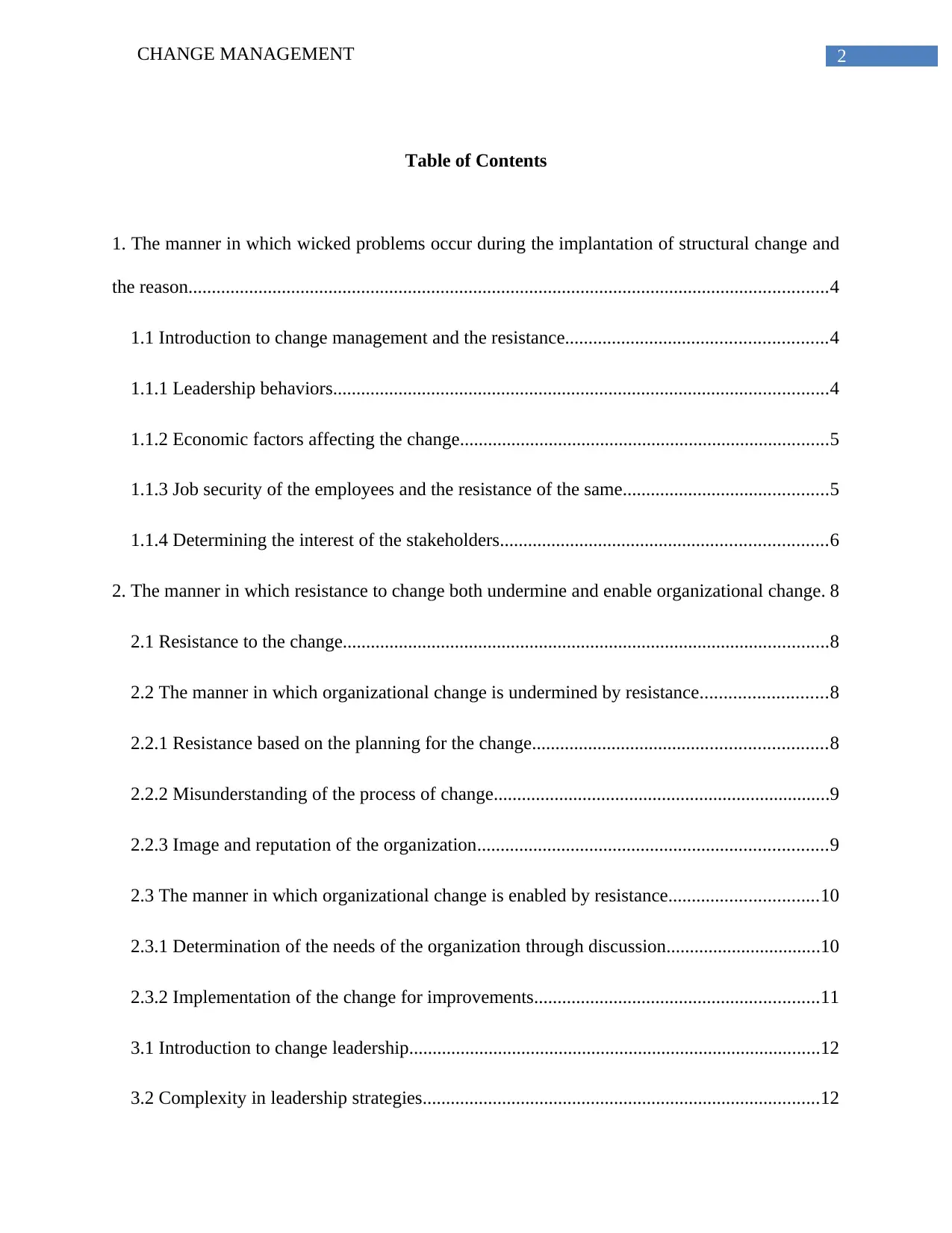
2CHANGE MANAGEMENT
Table of Contents
1. The manner in which wicked problems occur during the implantation of structural change and
the reason.........................................................................................................................................4
1.1 Introduction to change management and the resistance........................................................4
1.1.1 Leadership behaviors..........................................................................................................4
1.1.2 Economic factors affecting the change...............................................................................5
1.1.3 Job security of the employees and the resistance of the same............................................5
1.1.4 Determining the interest of the stakeholders......................................................................6
2. The manner in which resistance to change both undermine and enable organizational change. 8
2.1 Resistance to the change........................................................................................................8
2.2 The manner in which organizational change is undermined by resistance...........................8
2.2.1 Resistance based on the planning for the change...............................................................8
2.2.2 Misunderstanding of the process of change........................................................................9
2.2.3 Image and reputation of the organization...........................................................................9
2.3 The manner in which organizational change is enabled by resistance................................10
2.3.1 Determination of the needs of the organization through discussion.................................10
2.3.2 Implementation of the change for improvements.............................................................11
3.1 Introduction to change leadership........................................................................................12
3.2 Complexity in leadership strategies.....................................................................................12
Table of Contents
1. The manner in which wicked problems occur during the implantation of structural change and
the reason.........................................................................................................................................4
1.1 Introduction to change management and the resistance........................................................4
1.1.1 Leadership behaviors..........................................................................................................4
1.1.2 Economic factors affecting the change...............................................................................5
1.1.3 Job security of the employees and the resistance of the same............................................5
1.1.4 Determining the interest of the stakeholders......................................................................6
2. The manner in which resistance to change both undermine and enable organizational change. 8
2.1 Resistance to the change........................................................................................................8
2.2 The manner in which organizational change is undermined by resistance...........................8
2.2.1 Resistance based on the planning for the change...............................................................8
2.2.2 Misunderstanding of the process of change........................................................................9
2.2.3 Image and reputation of the organization...........................................................................9
2.3 The manner in which organizational change is enabled by resistance................................10
2.3.1 Determination of the needs of the organization through discussion.................................10
2.3.2 Implementation of the change for improvements.............................................................11
3.1 Introduction to change leadership........................................................................................12
3.2 Complexity in leadership strategies.....................................................................................12
⊘ This is a preview!⊘
Do you want full access?
Subscribe today to unlock all pages.

Trusted by 1+ million students worldwide
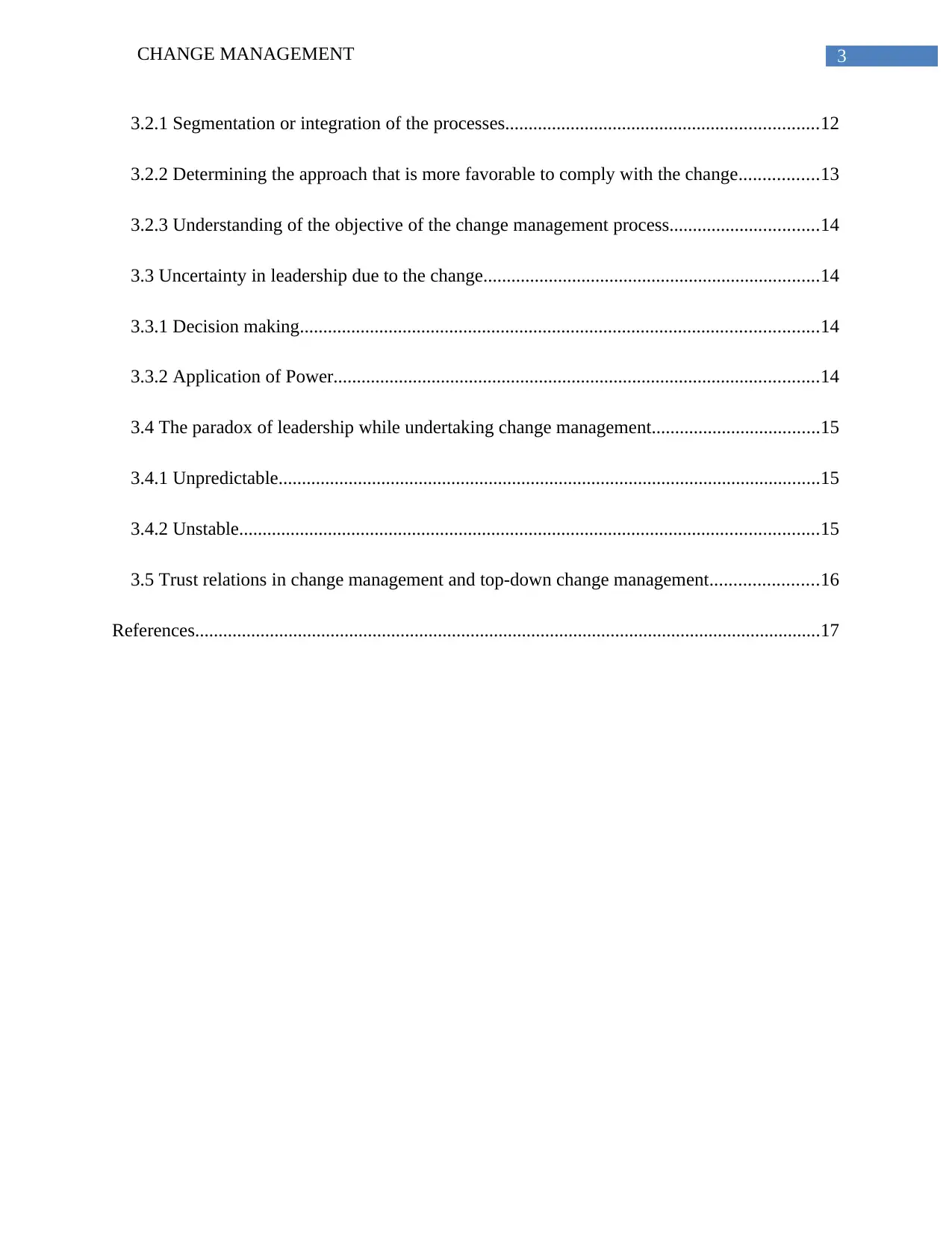
3CHANGE MANAGEMENT
3.2.1 Segmentation or integration of the processes...................................................................12
3.2.2 Determining the approach that is more favorable to comply with the change.................13
3.2.3 Understanding of the objective of the change management process................................14
3.3 Uncertainty in leadership due to the change........................................................................14
3.3.1 Decision making...............................................................................................................14
3.3.2 Application of Power........................................................................................................14
3.4 The paradox of leadership while undertaking change management....................................15
3.4.1 Unpredictable....................................................................................................................15
3.4.2 Unstable............................................................................................................................15
3.5 Trust relations in change management and top-down change management.......................16
References......................................................................................................................................17
3.2.1 Segmentation or integration of the processes...................................................................12
3.2.2 Determining the approach that is more favorable to comply with the change.................13
3.2.3 Understanding of the objective of the change management process................................14
3.3 Uncertainty in leadership due to the change........................................................................14
3.3.1 Decision making...............................................................................................................14
3.3.2 Application of Power........................................................................................................14
3.4 The paradox of leadership while undertaking change management....................................15
3.4.1 Unpredictable....................................................................................................................15
3.4.2 Unstable............................................................................................................................15
3.5 Trust relations in change management and top-down change management.......................16
References......................................................................................................................................17
Paraphrase This Document
Need a fresh take? Get an instant paraphrase of this document with our AI Paraphraser
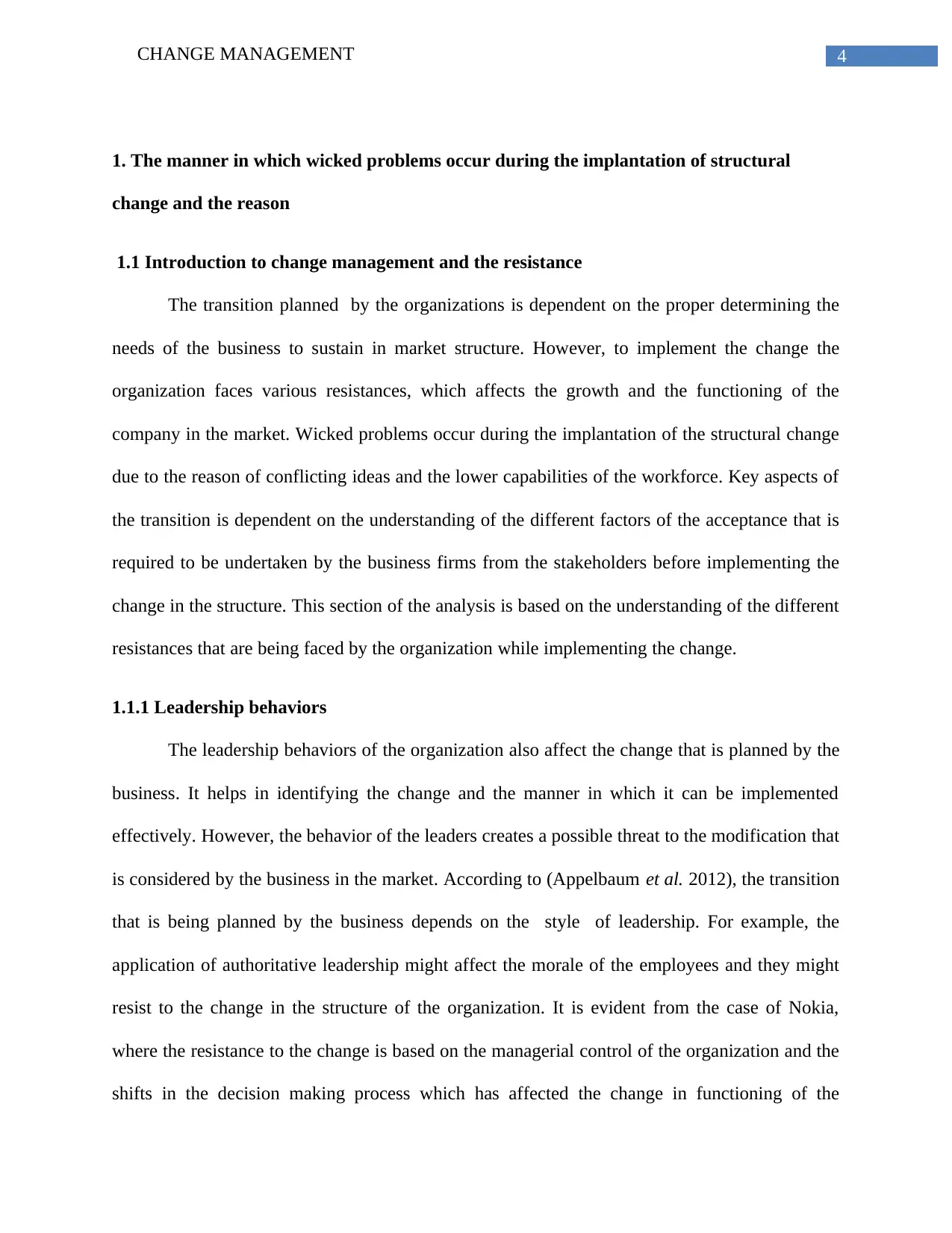
4CHANGE MANAGEMENT
1. The manner in which wicked problems occur during the implantation of structural
change and the reason
1.1 Introduction to change management and the resistance
The transition planned by the organizations is dependent on the proper determining the
needs of the business to sustain in market structure. However, to implement the change the
organization faces various resistances, which affects the growth and the functioning of the
company in the market. Wicked problems occur during the implantation of the structural change
due to the reason of conflicting ideas and the lower capabilities of the workforce. Key aspects of
the transition is dependent on the understanding of the different factors of the acceptance that is
required to be undertaken by the business firms from the stakeholders before implementing the
change in the structure. This section of the analysis is based on the understanding of the different
resistances that are being faced by the organization while implementing the change.
1.1.1 Leadership behaviors
The leadership behaviors of the organization also affect the change that is planned by the
business. It helps in identifying the change and the manner in which it can be implemented
effectively. However, the behavior of the leaders creates a possible threat to the modification that
is considered by the business in the market. According to (Appelbaum et al. 2012), the transition
that is being planned by the business depends on the style of leadership. For example, the
application of authoritative leadership might affect the morale of the employees and they might
resist to the change in the structure of the organization. It is evident from the case of Nokia,
where the resistance to the change is based on the managerial control of the organization and the
shifts in the decision making process which has affected the change in functioning of the
1. The manner in which wicked problems occur during the implantation of structural
change and the reason
1.1 Introduction to change management and the resistance
The transition planned by the organizations is dependent on the proper determining the
needs of the business to sustain in market structure. However, to implement the change the
organization faces various resistances, which affects the growth and the functioning of the
company in the market. Wicked problems occur during the implantation of the structural change
due to the reason of conflicting ideas and the lower capabilities of the workforce. Key aspects of
the transition is dependent on the understanding of the different factors of the acceptance that is
required to be undertaken by the business firms from the stakeholders before implementing the
change in the structure. This section of the analysis is based on the understanding of the different
resistances that are being faced by the organization while implementing the change.
1.1.1 Leadership behaviors
The leadership behaviors of the organization also affect the change that is planned by the
business. It helps in identifying the change and the manner in which it can be implemented
effectively. However, the behavior of the leaders creates a possible threat to the modification that
is considered by the business in the market. According to (Appelbaum et al. 2012), the transition
that is being planned by the business depends on the style of leadership. For example, the
application of authoritative leadership might affect the morale of the employees and they might
resist to the change in the structure of the organization. It is evident from the case of Nokia,
where the resistance to the change is based on the managerial control of the organization and the
shifts in the decision making process which has affected the change in functioning of the
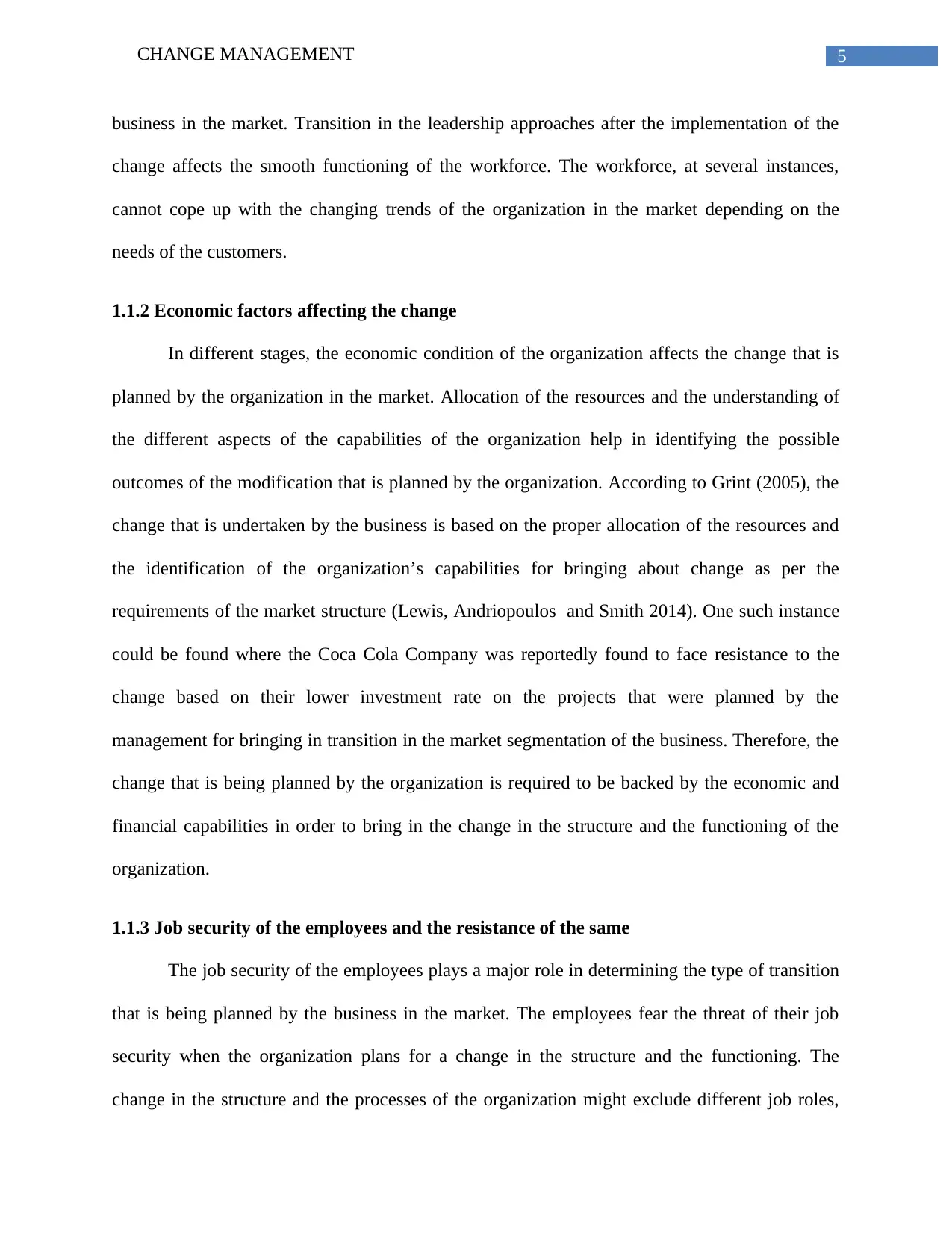
5CHANGE MANAGEMENT
business in the market. Transition in the leadership approaches after the implementation of the
change affects the smooth functioning of the workforce. The workforce, at several instances,
cannot cope up with the changing trends of the organization in the market depending on the
needs of the customers.
1.1.2 Economic factors affecting the change
In different stages, the economic condition of the organization affects the change that is
planned by the organization in the market. Allocation of the resources and the understanding of
the different aspects of the capabilities of the organization help in identifying the possible
outcomes of the modification that is planned by the organization. According to Grint (2005), the
change that is undertaken by the business is based on the proper allocation of the resources and
the identification of the organization’s capabilities for bringing about change as per the
requirements of the market structure (Lewis, Andriopoulos and Smith 2014). One such instance
could be found where the Coca Cola Company was reportedly found to face resistance to the
change based on their lower investment rate on the projects that were planned by the
management for bringing in transition in the market segmentation of the business. Therefore, the
change that is being planned by the organization is required to be backed by the economic and
financial capabilities in order to bring in the change in the structure and the functioning of the
organization.
1.1.3 Job security of the employees and the resistance of the same
The job security of the employees plays a major role in determining the type of transition
that is being planned by the business in the market. The employees fear the threat of their job
security when the organization plans for a change in the structure and the functioning. The
change in the structure and the processes of the organization might exclude different job roles,
business in the market. Transition in the leadership approaches after the implementation of the
change affects the smooth functioning of the workforce. The workforce, at several instances,
cannot cope up with the changing trends of the organization in the market depending on the
needs of the customers.
1.1.2 Economic factors affecting the change
In different stages, the economic condition of the organization affects the change that is
planned by the organization in the market. Allocation of the resources and the understanding of
the different aspects of the capabilities of the organization help in identifying the possible
outcomes of the modification that is planned by the organization. According to Grint (2005), the
change that is undertaken by the business is based on the proper allocation of the resources and
the identification of the organization’s capabilities for bringing about change as per the
requirements of the market structure (Lewis, Andriopoulos and Smith 2014). One such instance
could be found where the Coca Cola Company was reportedly found to face resistance to the
change based on their lower investment rate on the projects that were planned by the
management for bringing in transition in the market segmentation of the business. Therefore, the
change that is being planned by the organization is required to be backed by the economic and
financial capabilities in order to bring in the change in the structure and the functioning of the
organization.
1.1.3 Job security of the employees and the resistance of the same
The job security of the employees plays a major role in determining the type of transition
that is being planned by the business in the market. The employees fear the threat of their job
security when the organization plans for a change in the structure and the functioning. The
change in the structure and the processes of the organization might exclude different job roles,
⊘ This is a preview!⊘
Do you want full access?
Subscribe today to unlock all pages.

Trusted by 1+ million students worldwide
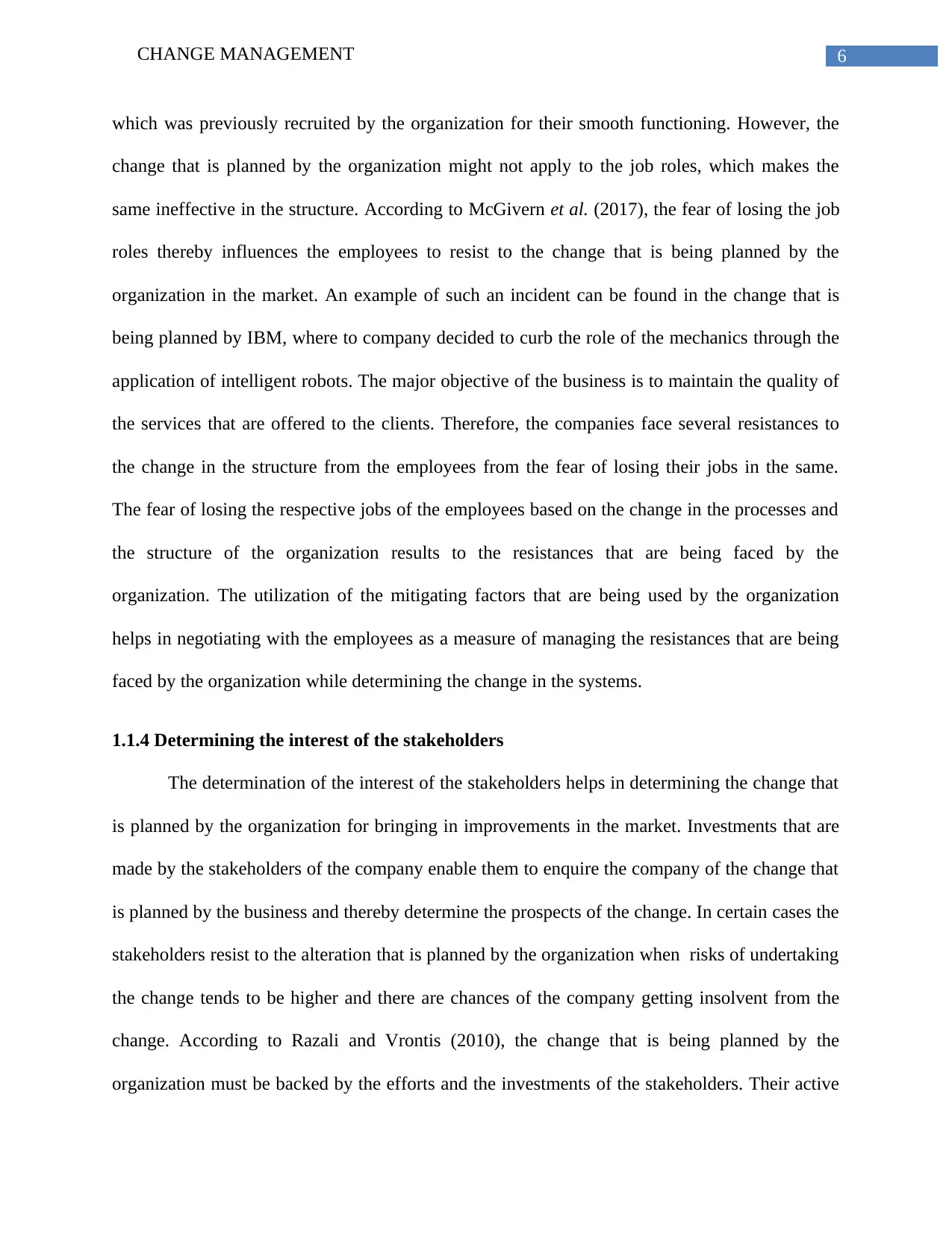
6CHANGE MANAGEMENT
which was previously recruited by the organization for their smooth functioning. However, the
change that is planned by the organization might not apply to the job roles, which makes the
same ineffective in the structure. According to McGivern et al. (2017), the fear of losing the job
roles thereby influences the employees to resist to the change that is being planned by the
organization in the market. An example of such an incident can be found in the change that is
being planned by IBM, where to company decided to curb the role of the mechanics through the
application of intelligent robots. The major objective of the business is to maintain the quality of
the services that are offered to the clients. Therefore, the companies face several resistances to
the change in the structure from the employees from the fear of losing their jobs in the same.
The fear of losing the respective jobs of the employees based on the change in the processes and
the structure of the organization results to the resistances that are being faced by the
organization. The utilization of the mitigating factors that are being used by the organization
helps in negotiating with the employees as a measure of managing the resistances that are being
faced by the organization while determining the change in the systems.
1.1.4 Determining the interest of the stakeholders
The determination of the interest of the stakeholders helps in determining the change that
is planned by the organization for bringing in improvements in the market. Investments that are
made by the stakeholders of the company enable them to enquire the company of the change that
is planned by the business and thereby determine the prospects of the change. In certain cases the
stakeholders resist to the alteration that is planned by the organization when risks of undertaking
the change tends to be higher and there are chances of the company getting insolvent from the
change. According to Razali and Vrontis (2010), the change that is being planned by the
organization must be backed by the efforts and the investments of the stakeholders. Their active
which was previously recruited by the organization for their smooth functioning. However, the
change that is planned by the organization might not apply to the job roles, which makes the
same ineffective in the structure. According to McGivern et al. (2017), the fear of losing the job
roles thereby influences the employees to resist to the change that is being planned by the
organization in the market. An example of such an incident can be found in the change that is
being planned by IBM, where to company decided to curb the role of the mechanics through the
application of intelligent robots. The major objective of the business is to maintain the quality of
the services that are offered to the clients. Therefore, the companies face several resistances to
the change in the structure from the employees from the fear of losing their jobs in the same.
The fear of losing the respective jobs of the employees based on the change in the processes and
the structure of the organization results to the resistances that are being faced by the
organization. The utilization of the mitigating factors that are being used by the organization
helps in negotiating with the employees as a measure of managing the resistances that are being
faced by the organization while determining the change in the systems.
1.1.4 Determining the interest of the stakeholders
The determination of the interest of the stakeholders helps in determining the change that
is planned by the organization for bringing in improvements in the market. Investments that are
made by the stakeholders of the company enable them to enquire the company of the change that
is planned by the business and thereby determine the prospects of the change. In certain cases the
stakeholders resist to the alteration that is planned by the organization when risks of undertaking
the change tends to be higher and there are chances of the company getting insolvent from the
change. According to Razali and Vrontis (2010), the change that is being planned by the
organization must be backed by the efforts and the investments of the stakeholders. Their active
Paraphrase This Document
Need a fresh take? Get an instant paraphrase of this document with our AI Paraphraser
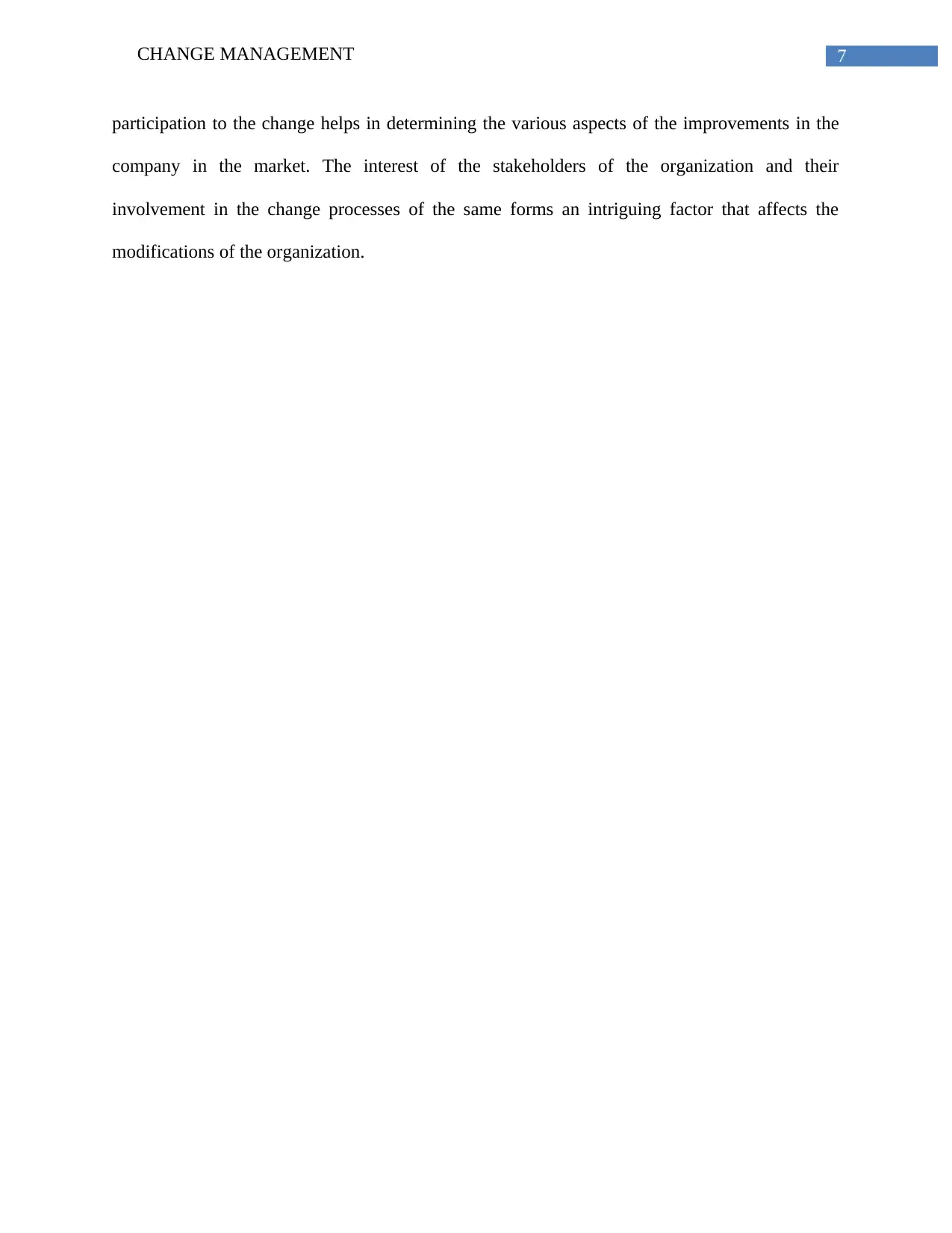
7CHANGE MANAGEMENT
participation to the change helps in determining the various aspects of the improvements in the
company in the market. The interest of the stakeholders of the organization and their
involvement in the change processes of the same forms an intriguing factor that affects the
modifications of the organization.
participation to the change helps in determining the various aspects of the improvements in the
company in the market. The interest of the stakeholders of the organization and their
involvement in the change processes of the same forms an intriguing factor that affects the
modifications of the organization.
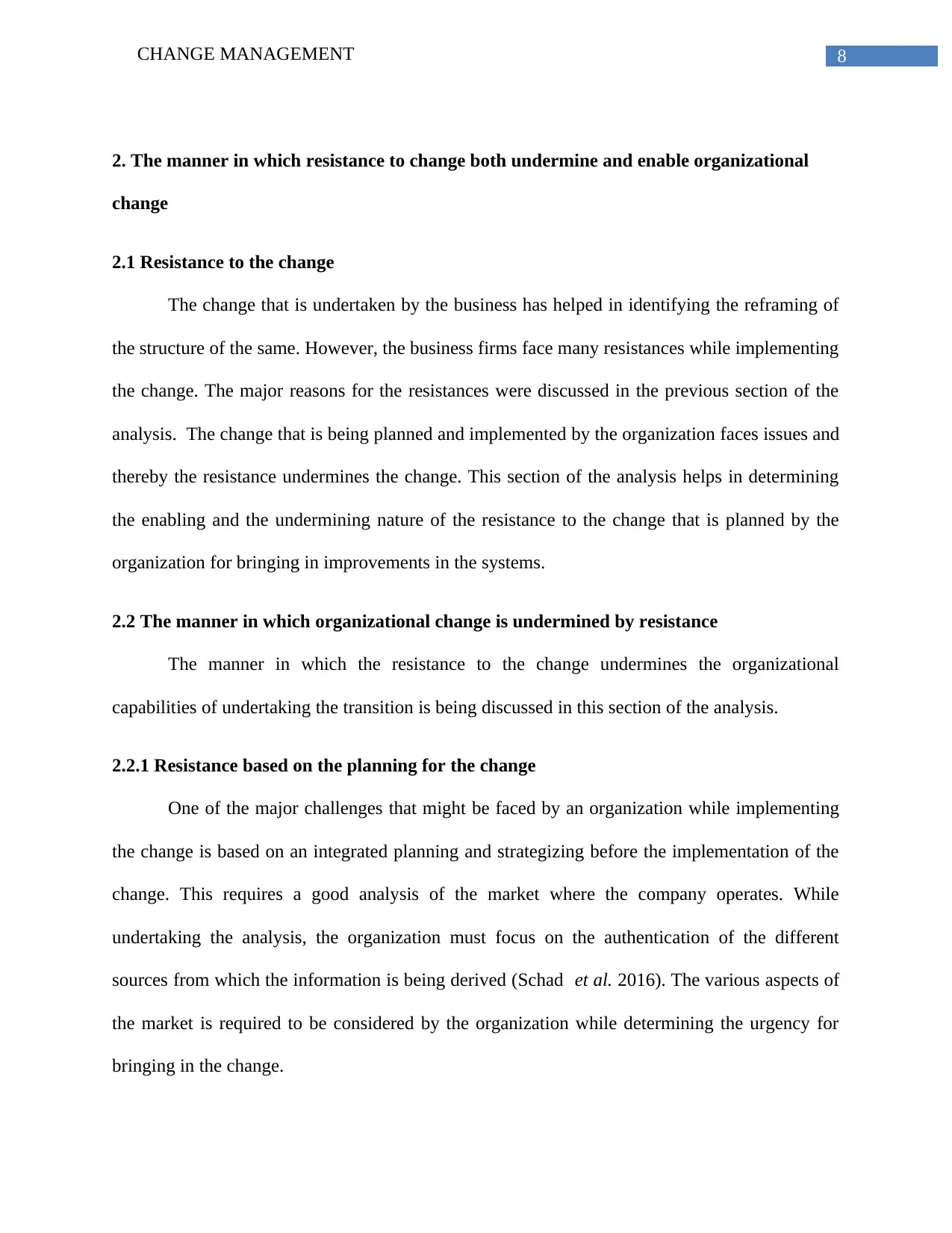
8CHANGE MANAGEMENT
2. The manner in which resistance to change both undermine and enable organizational
change
2.1 Resistance to the change
The change that is undertaken by the business has helped in identifying the reframing of
the structure of the same. However, the business firms face many resistances while implementing
the change. The major reasons for the resistances were discussed in the previous section of the
analysis. The change that is being planned and implemented by the organization faces issues and
thereby the resistance undermines the change. This section of the analysis helps in determining
the enabling and the undermining nature of the resistance to the change that is planned by the
organization for bringing in improvements in the systems.
2.2 The manner in which organizational change is undermined by resistance
The manner in which the resistance to the change undermines the organizational
capabilities of undertaking the transition is being discussed in this section of the analysis.
2.2.1 Resistance based on the planning for the change
One of the major challenges that might be faced by an organization while implementing
the change is based on an integrated planning and strategizing before the implementation of the
change. This requires a good analysis of the market where the company operates. While
undertaking the analysis, the organization must focus on the authentication of the different
sources from which the information is being derived (Schad et al. 2016). The various aspects of
the market is required to be considered by the organization while determining the urgency for
bringing in the change.
2. The manner in which resistance to change both undermine and enable organizational
change
2.1 Resistance to the change
The change that is undertaken by the business has helped in identifying the reframing of
the structure of the same. However, the business firms face many resistances while implementing
the change. The major reasons for the resistances were discussed in the previous section of the
analysis. The change that is being planned and implemented by the organization faces issues and
thereby the resistance undermines the change. This section of the analysis helps in determining
the enabling and the undermining nature of the resistance to the change that is planned by the
organization for bringing in improvements in the systems.
2.2 The manner in which organizational change is undermined by resistance
The manner in which the resistance to the change undermines the organizational
capabilities of undertaking the transition is being discussed in this section of the analysis.
2.2.1 Resistance based on the planning for the change
One of the major challenges that might be faced by an organization while implementing
the change is based on an integrated planning and strategizing before the implementation of the
change. This requires a good analysis of the market where the company operates. While
undertaking the analysis, the organization must focus on the authentication of the different
sources from which the information is being derived (Schad et al. 2016). The various aspects of
the market is required to be considered by the organization while determining the urgency for
bringing in the change.
⊘ This is a preview!⊘
Do you want full access?
Subscribe today to unlock all pages.

Trusted by 1+ million students worldwide
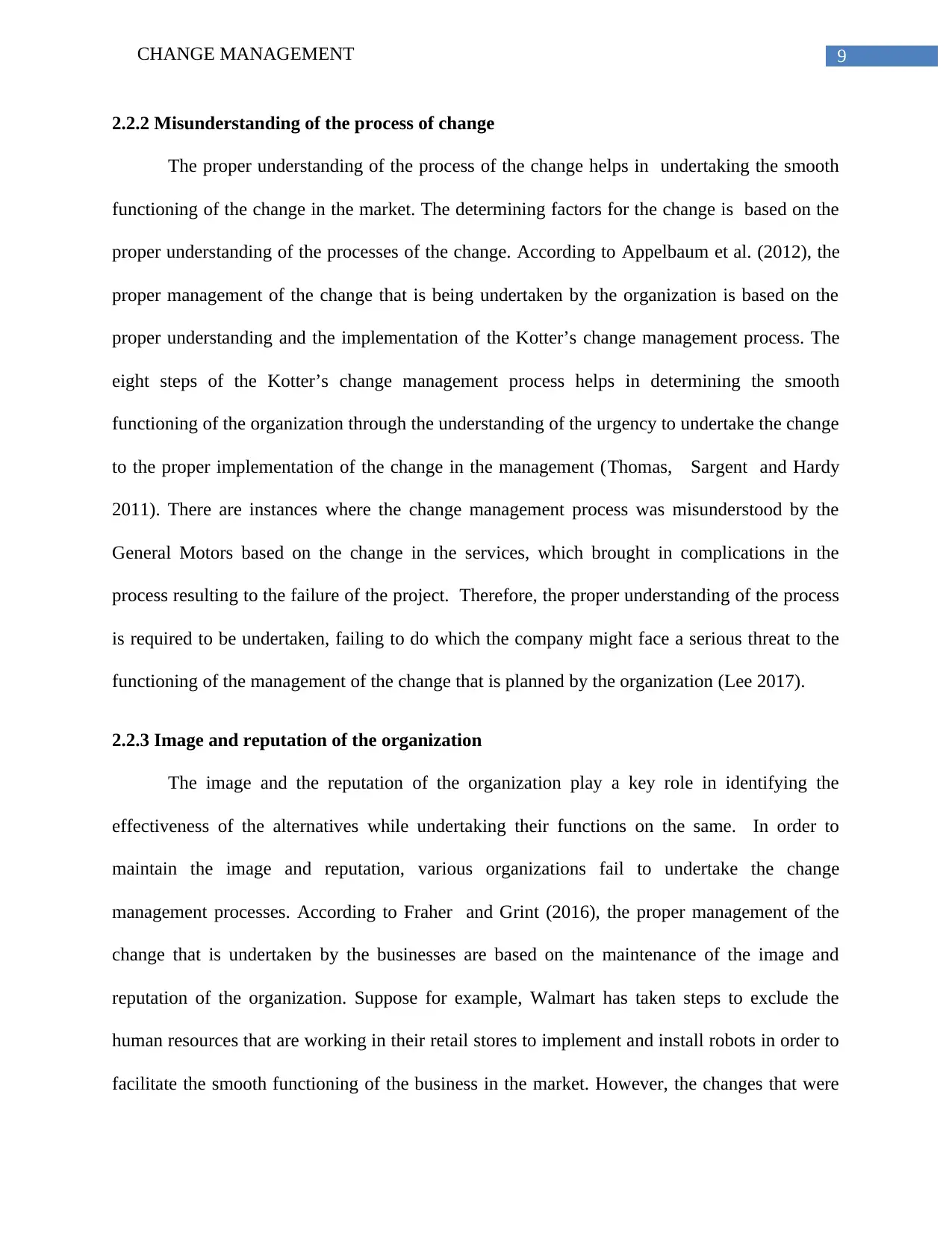
9CHANGE MANAGEMENT
2.2.2 Misunderstanding of the process of change
The proper understanding of the process of the change helps in undertaking the smooth
functioning of the change in the market. The determining factors for the change is based on the
proper understanding of the processes of the change. According to Appelbaum et al. (2012), the
proper management of the change that is being undertaken by the organization is based on the
proper understanding and the implementation of the Kotter’s change management process. The
eight steps of the Kotter’s change management process helps in determining the smooth
functioning of the organization through the understanding of the urgency to undertake the change
to the proper implementation of the change in the management (Thomas, Sargent and Hardy
2011). There are instances where the change management process was misunderstood by the
General Motors based on the change in the services, which brought in complications in the
process resulting to the failure of the project. Therefore, the proper understanding of the process
is required to be undertaken, failing to do which the company might face a serious threat to the
functioning of the management of the change that is planned by the organization (Lee 2017).
2.2.3 Image and reputation of the organization
The image and the reputation of the organization play a key role in identifying the
effectiveness of the alternatives while undertaking their functions on the same. In order to
maintain the image and reputation, various organizations fail to undertake the change
management processes. According to Fraher and Grint (2016), the proper management of the
change that is undertaken by the businesses are based on the maintenance of the image and
reputation of the organization. Suppose for example, Walmart has taken steps to exclude the
human resources that are working in their retail stores to implement and install robots in order to
facilitate the smooth functioning of the business in the market. However, the changes that were
2.2.2 Misunderstanding of the process of change
The proper understanding of the process of the change helps in undertaking the smooth
functioning of the change in the market. The determining factors for the change is based on the
proper understanding of the processes of the change. According to Appelbaum et al. (2012), the
proper management of the change that is being undertaken by the organization is based on the
proper understanding and the implementation of the Kotter’s change management process. The
eight steps of the Kotter’s change management process helps in determining the smooth
functioning of the organization through the understanding of the urgency to undertake the change
to the proper implementation of the change in the management (Thomas, Sargent and Hardy
2011). There are instances where the change management process was misunderstood by the
General Motors based on the change in the services, which brought in complications in the
process resulting to the failure of the project. Therefore, the proper understanding of the process
is required to be undertaken, failing to do which the company might face a serious threat to the
functioning of the management of the change that is planned by the organization (Lee 2017).
2.2.3 Image and reputation of the organization
The image and the reputation of the organization play a key role in identifying the
effectiveness of the alternatives while undertaking their functions on the same. In order to
maintain the image and reputation, various organizations fail to undertake the change
management processes. According to Fraher and Grint (2016), the proper management of the
change that is undertaken by the businesses are based on the maintenance of the image and
reputation of the organization. Suppose for example, Walmart has taken steps to exclude the
human resources that are working in their retail stores to implement and install robots in order to
facilitate the smooth functioning of the business in the market. However, the changes that were
Paraphrase This Document
Need a fresh take? Get an instant paraphrase of this document with our AI Paraphraser
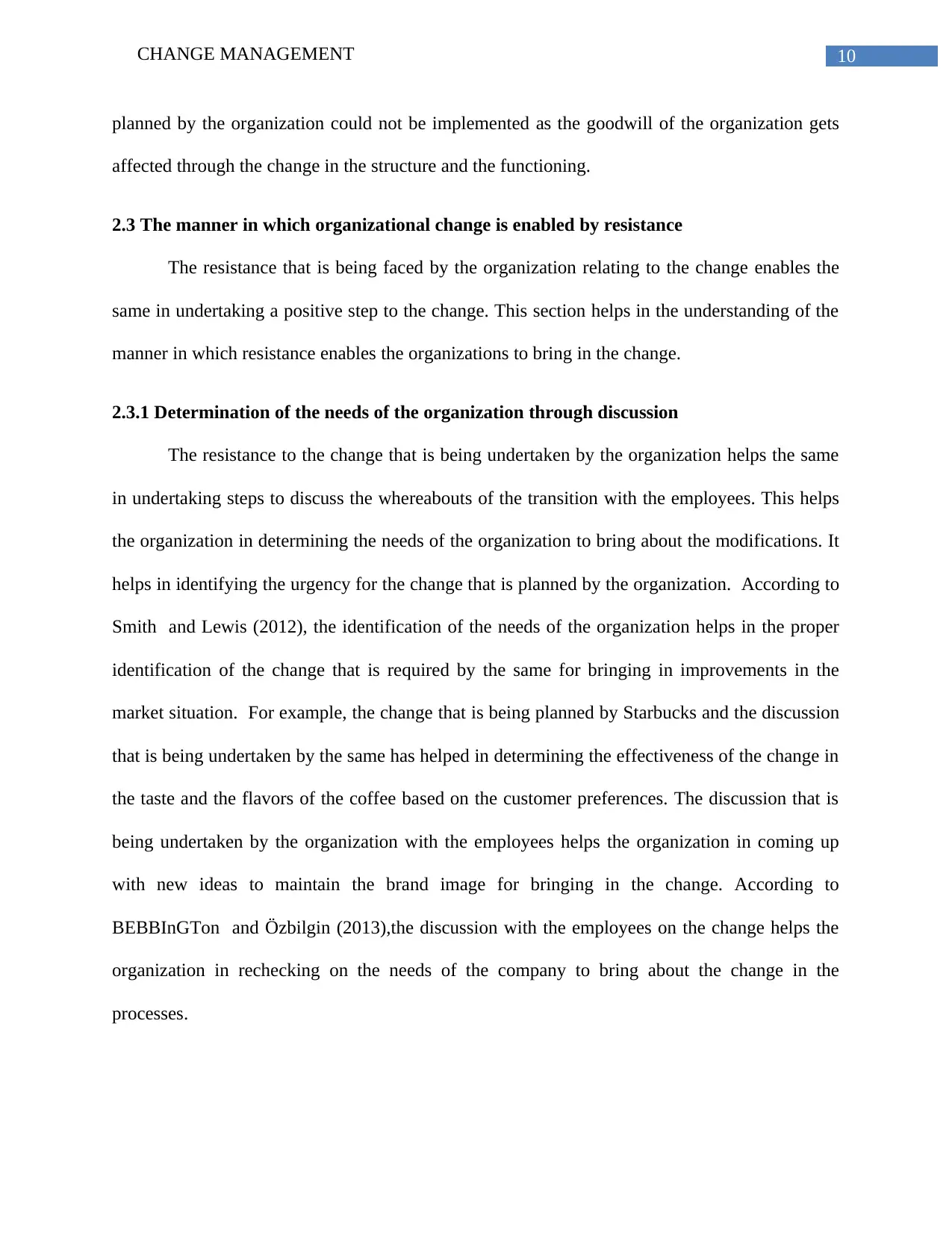
10CHANGE MANAGEMENT
planned by the organization could not be implemented as the goodwill of the organization gets
affected through the change in the structure and the functioning.
2.3 The manner in which organizational change is enabled by resistance
The resistance that is being faced by the organization relating to the change enables the
same in undertaking a positive step to the change. This section helps in the understanding of the
manner in which resistance enables the organizations to bring in the change.
2.3.1 Determination of the needs of the organization through discussion
The resistance to the change that is being undertaken by the organization helps the same
in undertaking steps to discuss the whereabouts of the transition with the employees. This helps
the organization in determining the needs of the organization to bring about the modifications. It
helps in identifying the urgency for the change that is planned by the organization. According to
Smith and Lewis (2012), the identification of the needs of the organization helps in the proper
identification of the change that is required by the same for bringing in improvements in the
market situation. For example, the change that is being planned by Starbucks and the discussion
that is being undertaken by the same has helped in determining the effectiveness of the change in
the taste and the flavors of the coffee based on the customer preferences. The discussion that is
being undertaken by the organization with the employees helps the organization in coming up
with new ideas to maintain the brand image for bringing in the change. According to
BEBBInGTon and Özbilgin (2013),the discussion with the employees on the change helps the
organization in rechecking on the needs of the company to bring about the change in the
processes.
planned by the organization could not be implemented as the goodwill of the organization gets
affected through the change in the structure and the functioning.
2.3 The manner in which organizational change is enabled by resistance
The resistance that is being faced by the organization relating to the change enables the
same in undertaking a positive step to the change. This section helps in the understanding of the
manner in which resistance enables the organizations to bring in the change.
2.3.1 Determination of the needs of the organization through discussion
The resistance to the change that is being undertaken by the organization helps the same
in undertaking steps to discuss the whereabouts of the transition with the employees. This helps
the organization in determining the needs of the organization to bring about the modifications. It
helps in identifying the urgency for the change that is planned by the organization. According to
Smith and Lewis (2012), the identification of the needs of the organization helps in the proper
identification of the change that is required by the same for bringing in improvements in the
market situation. For example, the change that is being planned by Starbucks and the discussion
that is being undertaken by the same has helped in determining the effectiveness of the change in
the taste and the flavors of the coffee based on the customer preferences. The discussion that is
being undertaken by the organization with the employees helps the organization in coming up
with new ideas to maintain the brand image for bringing in the change. According to
BEBBInGTon and Özbilgin (2013),the discussion with the employees on the change helps the
organization in rechecking on the needs of the company to bring about the change in the
processes.
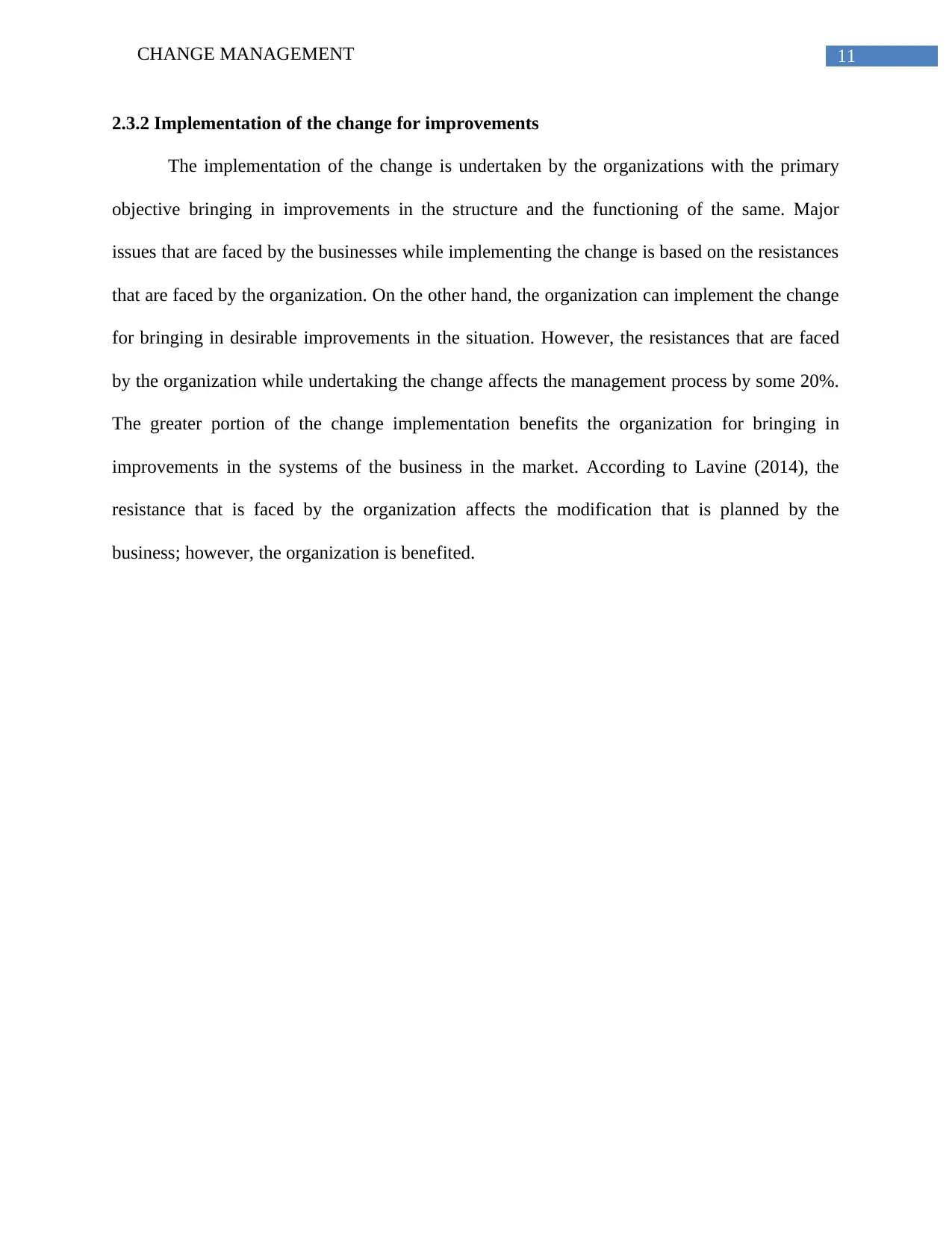
11CHANGE MANAGEMENT
2.3.2 Implementation of the change for improvements
The implementation of the change is undertaken by the organizations with the primary
objective bringing in improvements in the structure and the functioning of the same. Major
issues that are faced by the businesses while implementing the change is based on the resistances
that are faced by the organization. On the other hand, the organization can implement the change
for bringing in desirable improvements in the situation. However, the resistances that are faced
by the organization while undertaking the change affects the management process by some 20%.
The greater portion of the change implementation benefits the organization for bringing in
improvements in the systems of the business in the market. According to Lavine (2014), the
resistance that is faced by the organization affects the modification that is planned by the
business; however, the organization is benefited.
2.3.2 Implementation of the change for improvements
The implementation of the change is undertaken by the organizations with the primary
objective bringing in improvements in the structure and the functioning of the same. Major
issues that are faced by the businesses while implementing the change is based on the resistances
that are faced by the organization. On the other hand, the organization can implement the change
for bringing in desirable improvements in the situation. However, the resistances that are faced
by the organization while undertaking the change affects the management process by some 20%.
The greater portion of the change implementation benefits the organization for bringing in
improvements in the systems of the business in the market. According to Lavine (2014), the
resistance that is faced by the organization affects the modification that is planned by the
business; however, the organization is benefited.
⊘ This is a preview!⊘
Do you want full access?
Subscribe today to unlock all pages.

Trusted by 1+ million students worldwide
1 out of 21
Related Documents
Your All-in-One AI-Powered Toolkit for Academic Success.
+13062052269
info@desklib.com
Available 24*7 on WhatsApp / Email
![[object Object]](/_next/static/media/star-bottom.7253800d.svg)
Unlock your academic potential
Copyright © 2020–2025 A2Z Services. All Rights Reserved. Developed and managed by ZUCOL.




